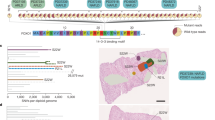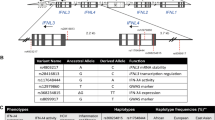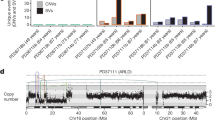Abstract
The most common risk factor for developing hepatocellular carcinoma (HCC) is chronic infection with hepatitis B virus (HBV). To better understand the evolutionary forces driving HCC, we performed a near-saturating transposon mutagenesis screen in a mouse HBV model of HCC. This screen identified 21 candidate early stage drivers and a very large number (2,860) of candidate later stage drivers that were enriched for genes that are mutated, deregulated or functioning in signaling pathways important for human HCC, with a striking 1,199 genes being linked to cellular metabolic processes. Our study provides a comprehensive overview of the genetic landscape of HCC.
This is a preview of subscription content, access via your institution
Access options
Subscribe to this journal
Receive 12 print issues and online access
$209.00 per year
only $17.42 per issue
Buy this article
- Purchase on Springer Link
- Instant access to full article PDF
Prices may be subject to local taxes which are calculated during checkout






Similar content being viewed by others
Accession codes
References
Chen, X. et al. Gene expression patterns in human liver cancers. Mol. Biol. Cell 13, 1929–1939 (2002).
Imbeaud, S., Ladeiro, Y. & Zucman-Rossi, J. Identification of novel oncogenes and tumor suppressors in hepatocellular carcinoma. Semin. Liver Dis. 30, 75–86 (2010).
Mas, V.R. et al. Genes involved in viral carcinogenesis and tumor initiation in hepatitis C virus–induced hepatocellular carcinoma. Mol. Med. 15, 85–94 (2009).
Roessler, S. et al. A unique metastasis gene signature enables prediction of tumor relapse in early-stage hepatocellular carcinoma patients. Cancer Res. 70, 10202–10212 (2010).
Wurmbach, E. et al. Genome-wide molecular profiles of HCV-induced dysplasia and hepatocellular carcinoma. Hepatology 45, 938–947 (2007).
Herath, N.I., Leggett, B.A. & MacDonald, G.A. Review of genetic and epigenetic alterations in hepatocarcinogenesis. J. Gastroenterol. Hepatol. 21, 15–21 (2006).
Herceg, Z. & Paliwal, A. Epigenetic mechanisms in hepatocellular carcinoma: how environmental factors influence the epigenome. Mutat. Res. 727, 55–61 (2011).
Berger, A.H., Knudson, A.G. & Pandolfi, P.P. A continuum model for tumour suppression. Nature 476, 163–169 (2011).
ENCODE Project Consortium. et al. An integrated encyclopedia of DNA elements in the human genome. Nature 489, 57–74 (2012).
Fujimoto, A. et al. Whole-genome sequencing of liver cancers identifies etiological influences on mutation patterns and recurrent mutations in chromatin regulators. Nat. Genet. 44, 760–764 (2012).
Guichard, C. et al. Integrated analysis of somatic mutations and focal copy-number changes identifies key genes and pathways in hepatocellular carcinoma. Nat. Genet. 44, 694–698 (2012).
Copeland, N.G. & Jenkins, N.A. Harnessing transposons for cancer gene discovery. Nat. Rev. Cancer 10, 696–706 (2010).
Dupuy, A.J., Akagi, K., Largaespada, D.A., Copeland, N.G. & Jenkins, N.A. Mammalian mutagenesis using a highly mobile somatic Sleeping Beauty transposon system. Nature 436, 221–226 (2005).
Dupuy, A.J. et al. A modified sleeping beauty transposon system that can be used to model a wide variety of human cancers in mice. Cancer Res. 69, 8150–8156 (2009).
Rad, R. et al. PiggyBac transposon mutagenesis: a tool for cancer gene discovery in mice. Science 330, 1104–1107 (2010).
Yang, J.D. & Roberts, L.R. Hepatocellular carcinoma: a global view. Nat. Rev. Gastroenterol. Hepatol. 7, 448–458 (2010).
Keng, V.W. et al. A conditional transposon-based insertional mutagenesis screen for genes associated with mouse hepatocellular carcinoma. Nat. Biotechnol. 27, 264–274 (2009).
Chisari, F.V. et al. Molecular pathogenesis of hepatocellular carcinoma in hepatitis B virus transgenic mice. Cell 59, 1145–1156 (1989).
Mann, K.M. et al. Sleeping Beauty mutagenesis reveals cooperating mutations and pathways in pancreatic adenocarcinoma. Proc. Natl. Acad. Sci. USA 109, 5934–5941 (2012).
Brett, B.T. et al. Novel molecular and computational methods improve the accuracy of insertion site analysis in Sleeping Beauty–induced tumors. PLoS ONE 6, e24668 (2011).
de Ridder, J., Uren, A., Kool, J., Reinders, M. & Wessels, L. Detecting statistically significant common insertion sites in retroviral insertional mutagenesis screens. PLoS Comput. Biol. 2, e166 (2006).
March, H.N. et al. Insertional mutagenesis identifies multiple networks of cooperating genes driving intestinal tumorigenesis. Nat. Genet. 43, 1202–1209 (2011).
Swanton, C. Intratumor heterogeneity: evolution through space and time. Cancer Res. 72, 4875–4882 (2012).
Pérez-Mancera, P.A. et al. The deubiquitinase USP9X suppresses pancreatic ductal adenocarcinoma. Nature 486, 266–270 (2012).
Solimini, N.L. et al. Recurrent hemizygous deletions in cancers may optimize proliferative potential. Science 337, 104–109 (2012).
Whittaker, S., Marais, R. & Zhu, A.X. The role of signaling pathways in the development and treatment of hepatocellular carcinoma. Oncogene 29, 4989–5005 (2010).
Schmidt, V.A., Chiariello, C.S., Capilla, E., Miller, F. & Bahou, W.F. Development of hepatocellular carcinoma in Iqgap2-deficient mice is IQGAP1 dependent. Mol. Cell. Biol. 28, 1489–1502 (2008).
Zhang, G., Liu, T. & Wang, Z. Downregulation of MAGI1 associates with poor prognosis of hepatocellular carcinoma. J. Invest. Surg. 25, 93–99 (2012).
Horie, Y. et al. Hepatocyte-specific Pten deficiency results in steatohepatitis and hepatocellular carcinomas. J. Clin. Invest. 113, 1774–1783 (2004).
Lu, L. et al. Hippo signaling is a potent in vivo growth and tumor suppressor pathway in the mammalian liver. Proc. Natl. Acad. Sci. USA 107, 1437–1442 (2010).
Zheng, T., Wang, J., Jiang, H. & Liu, L. Hippo signaling in oval cells and hepatocarcinogenesis. Cancer Lett. 302, 91–99 (2011).
Santhekadur, P.K. et al. Multifunction protein staphylococcal nuclease domain containing 1 (SND1) promotes tumor angiogenesis in human hepatocellular carcinoma through novel pathway that involves nuclear factor κB and miR-221. J. Biol. Chem. 287, 13952–13958 (2012).
Yoo, B.K. et al. Increased RNA-induced silencing complex (RISC) activity contributes to hepatocellular carcinoma. Hepatology 53, 1538–1548 (2011).
Kojima, K. et al. MicroRNA122 is a key regulator of α-fetoprotein expression and influences the aggressiveness of hepatocellular carcinoma. Nat. Commun. 2, 338 (2011).
Xie, Z. et al. Zinc finger protein ZBTB20 is a key repressor of α-fetoprotein gene transcription in liver. Proc. Natl. Acad. Sci. USA 105, 10859–10864 (2008).
Flaim, C.J., Chien, S. & Bhatia, S.N. An extracellular matrix microarray for probing cellular differentiation. Nat. Methods 2, 119–125 (2005).
Watt, A.J. et al. A gene trap integration provides an early in situ marker for hepatic specification of the foregut endoderm. Mech. Dev. 100, 205–215 (2001).
Duns, G. et al. Histone methyltransferase gene SETD2 is a novel tumor suppressor gene in clear cell renal cell carcinoma. Cancer Res. 70, 4287–4291 (2010).
Jackson, R.C., Morris, H.P. & Weber, G. Adenosine deaminase and adenosine kinase in rat hepatomas and kidney tumours. Br. J. Cancer 37, 701–713 (1978).
Nii, A. et al. Significance of dihydropyrimidine dehydrogenase and thymidylate synthase mRNA expressions in hepatocellular carcinoma. Hepatol. Res. 39, 274–281 (2009).
Queener, S.F., Morris, H.P. & Weber, G. Dihydrouracil dehydrogenase activity in normal, differentiating and regnerating liver and in hepatomas. Cancer Res. 31, 1004–1009 (1971).
Cheng, F. et al. Camptothecin-induced downregulation of MLL5 contributes to the activation of tumor suppressor p53. Oncogene 30, 3599–3611 (2011).
Bernard, F. et al. Alterations of NFIA in chronic malignant myeloid diseases. Leukemia 23, 583–585 (2009).
Johnson, M.R., Look, A.T., DeClue, J.E., Valentine, M.B. & Lowy, D.R. Inactivation of the NF1 gene in human melanoma and neuroblastoma cell lines without impaired regulation of GTP.Ras. Proc. Natl. Acad. Sci. USA 90, 5539–5543 (1993).
Vinciguerra, M. & Foti, M. PTEN at the crossroad of metabolic diseases and cancer in the liver. Ann. Hepatol. 7, 192–199 (2008).
Cohen, P. & Frame, S. The renaissance of GSK3. Nat. Rev. Mol. Cell Biol. 2, 769–776 (2001).
Bjursell, M.K. et al. Adenosine kinase deficiency disrupts the methionine cycle and causes hypermethioninemia, encephalopathy, and abnormal liver function. Am. J. Hum. Genet. 89, 507–515 (2011).
Boison, D. et al. Neonatal hepatic steatosis by disruption of the adenosine kinase gene. Proc. Natl. Acad. Sci. USA 99, 6985–6990 (2002).
Sutherland, A.P. et al. Zinc finger protein Zbtb20 is essential for postnatal survival and glucose homeostasis. Mol. Cell. Biol. 29, 2804–2815 (2009).
Fan, Y. et al. Liver-specific deletion of the growth hormone receptor reveals essential role of growth hormone signaling in hepatic lipid metabolism. J. Biol. Chem. 284, 19937–19944 (2009).
Mavalli, M.D. et al. Distinct growth hormone receptor signaling modes regulate skeletal muscle development and insulin sensitivity in mice. J. Clin. Invest. 120, 4007–4020 (2010).
da Rocha, S.T., Edwards, C.A., Ito, M., Ogata, T. & Ferguson-Smith, A.C. Genomic imprinting at the mammalian Dlk1-Dio3 domain. Trends Genet. 24, 306–316 (2008).
Luk, J.M. et al. DLK1–DIO3 genomic imprinted microRNA cluster at 14q32.2 defines a stemlike subtype of hepatocellular carcinoma associated with poor survival. J. Biol. Chem. 286, 30706–30713 (2011).
Sung, W.K. et al. Genome-wide survey of recurrent HBV integration in hepatocellular carcinoma. Nat. Genet. 44, 765–769 (2012).
Edgar, B.A. From cell structure to transcription: Hippo forges a new path. Cell 124, 267–273 (2006).
Budhu, A. et al. Integrated metabolite and gene expression profiles identify lipid biomarkers associated with progression of hepatocellular carcinoma and patient outcomes. Gastroenterology 144, 1066–1075 (2013).
Lee, P. et al. In vivo hyperpolarized carbon-13 magnetic resonance spectroscopy reveals increased pyruvate carboxylase flux in an insulin resistant mouse model. Hepatology 57, 515–524 (2013).
DeBerardinis, R.J. & Cheng, T. Q's next: the diverse functions of glutamine in metabolism, cell biology and cancer. Oncogene 29, 313–324 (2010).
Beyoğlu, D. et al. Tissue metabolomics of hepatocellular carcinoma: tumor energy metabolism and the role of transcriptomic classification. Hepatology 58, 229–238 (2013).
Anderson, K. et al. Genetic variegation of clonal architecture and propagating cells in leukaemia. Nature 469, 356–361 (2011).
Hou, Y. et al. Single-cell exome sequencing and monoclonal evolution of a JAK2-negative myeloproliferative neoplasm. Cell 148, 873–885 (2012).
Gerlinger, M. et al. Intratumor heterogeneity and branched evolution revealed by multiregion sequencing. N. Engl. J. Med. 366, 883–892 (2012).
Berquam-Vrieze, K.E. et al. Cell of origin strongly influences genetic selection in a mouse model of T-ALL. Blood 118, 4646–4656 (2011).
Gao, H. et al. Application of 1H NMR-based metabonomics in the study of metabolic profiling of human hepatocellular carcinoma and liver cirrhosis. Cancer Sci. 100, 782–785 (2009).
Wang, B. et al. Metabonomic profiles discriminate hepatocellular carcinoma from liver cirrhosis by ultraperformance liquid chromatography-mass spectrometry. J. Proteome Res. 11, 1217–1227 (2012).
Yang, Y. et al. Metabonomic studies of human hepatocellular carcinoma using high-resolution magic-angle spinning 1H NMR spectroscopy in conjunction with multivariate data analysis. J. Proteome Res. 6, 2605–2614 (2007).
Ward, P.S. & Thompson, C.B. Metabolic reprogramming: a cancer hallmark even Warburg did not anticipate. Cancer Cell 21, 297–308 (2012).
Chen, T. et al. Serum and urine metabolite profiling reveals potential biomarkers of human hepatocellular carcinoma. Mol. Cell. Proteomics 10, M110.004945 (2011).
Cairns, R.A., Harris, I.S. & Mak, T.W. Regulation of cancer cell metabolism. Nat. Rev. Cancer 11, 85–95 (2011).
Christofk, H.R. et al. The M2 splice isoform of pyruvate kinase is important for cancer metabolism and tumour growth. Nature 452, 230–233 (2008).
David, C.J., Chen, M., Assanah, M., Canoll, P. & Manley, J.L. HnRNP proteins controlled by c-Myc deregulate pyruvate kinase mRNA splicing in cancer. Nature 463, 364–368 (2010).
DeBerardinis, R.J. et al. Beyond aerobic glycolysis: transformed cells can engage in glutamine metabolism that exceeds the requirement for protein and nucleotide synthesis. Proc. Natl. Acad. Sci. USA 104, 19345–19350 (2007).
Wise, D.R. et al. Hypoxia promotes isocitrate dehydrogenase–dependent carboxylation of α-ketoglutarate to citrate to support cell growth and viability. Proc. Natl. Acad. Sci. USA 108, 19611–19616 (2011).
Vander Heiden, M.G. Targeting cancer metabolism: a therapeutic window opens. Nat. Rev. Drug Discov. 10, 671–684 (2011).
Postic, C. & Magnuson, M.A. DNA excision in liver by an albumin-Cre transgene occurs progressively with age. Genesis 26, 149–150 (2000).
Thoolen, B. et al. Proliferative and nonproliferative lesions of the rat and mouse hepatobiliary system. Toxicol. Pathol. 38, 5S–81S (2010).
Morrow, M., Samanta, A., Kioussis, D., Brady, H.J. & Williams, O. TEL-AML1 preleukemic activity requires the DNA binding domain of AML1 and the dimerization and corepressor binding domains of TEL. Oncogene 26, 4404–4414 (2007).
Jee, J. et al. ACT: aggregation and correlation toolbox for analyses of genome tracks. Bioinformatics 27, 1152–1154 (2011).
Eppig, J.T. et al. Mouse genome informatics (MGI) resources for pathology and toxicology. Toxicol. Pathol. 35, 456–457 (2007).
Kasprzyk, A. BioMart: driving a paradigm change in biological data management. Database (Oxford) 2011, bar049 (2011).
Sayers, E.W. et al. Database resources of the National Center for Biotechnology Information. Nucleic Acids Res. 40, D13–D25 (2012).
Chew, V. et al. Chemokine-driven lymphocyte infiltration: an early intratumoural event determining long-term survival in resectable hepatocellular carcinoma. Gut 61, 427–438 (2012).
Spurgeon, S.L., Jones, R.C. & Ramakrishnan, R. High throughput gene expression measurement with real time PCR in a microfluidic dynamic array. PLoS One 3, e1662 (2008).
Schmittgen, T.D. & Livak, K.J. Analyzing real-time PCR data by the comparative C(T) method. Nat. Protoc. 3, 1101–1108 (2008).
Huang, W., Sherman, B.T. & Lempicki, R.A. Systematic and integrative analysis of large gene lists using DAVID bioinformatics resources. Nat. Protoc. 4, 44–57 (2009).
Eisen, M.B., Spellman, P.T., Brown, P.O. & Botstein, D. Cluster analysis and display of genome-wide expression patterns. Proc. Natl. Acad. Sci. USA 95, 14863–14868 (1998).
Schroeder, M.A. et al. Measuring intracellular pH in the heart using hyperpolarized carbon dioxide and bicarbonate: a 13C and 31P magnetic resonance spectroscopy study. Cardiovasc. Res. 86, 82–91 (2010).
Acknowledgements
We acknowledge K. Reifenberg at Johannes Gutenberg University, Germany, for giving us the HBsAg mouse strain (originated from F. Chisari). We also thank K. Rogers and S. Rogers at the Institute of Molecular and Cell Biology Histopathology core for their necropsy and histotechnology assistance. We thank P. Cheok, N. Lim and D. Chen for their help with mouse breeding and monitoring. This work was supported by the Biomedical Research Council, Agency for Science, Technology and Research, Singapore and the Cancer Prevention Research Institute of Texas (CPRIT). A.G.R. and D.J.A. are supported by the Wellcome Trust and Cancer Research UK. N.A.J. and N.G.C. are both CPRIT Scholars in Cancer Research.
Author information
Authors and Affiliations
Contributions
E.A.B.-C. performed the majority of experiments, designed experiments, analyzed data and wrote the manuscript. A.-T.N. performed experiments, analyzed data and wrote the manuscript. A.G.R. and D.J.A. sequenced the samples and processed and analyzed data. A.S., C.K.Y.C., T.B., R.S. and F.A.B. performed computational analyses. B.Q.C. executed experiments. E.C.Y.C. and L.-S.N. performed the metabolomics study. P.L. and G.K.R. carried out in vivo metabolic imaging and metabolic assays. J.M.W. analyzed mouse hepatic pathology. J.-P.A., V.C. and H.C.T. provided and processed human patient samples. A.J.D. helped analyze data, and R.L.J. carried out the liver-SB screen in the Sav1 mutant background. J.d.J. and L.F.A.W. revised statistics and performed analyses. N.G.C. and N.A.J. designed the study, analyzed the data and wrote the manuscript. All authors commented on and edited the final manuscript.
Corresponding author
Ethics declarations
Competing interests
The authors declare no competing financial interests.
Supplementary information
Supplementary Text and Figures
Supplementary Figures 1–19 (PDF 4223 kb)
Supplementary Table 1
Supplementary Table 1 (XLSX 877 kb)
Supplementary Table 2
Supplementary Table 2 (XLSX 172 kb)
Supplementary Table 3
Supplementary Table 3 (XLSX 172 kb)
Supplementary Table 4
Supplementary Table 4 (XLSX 27 kb)
Supplementary Table 5
Supplementary Table 5 (XLSX 15 kb)
Supplementary Table 6
Supplementary Table 6 (XLSX 467 kb)
Supplementary Table 7
Supplementary Table 7 (XLSX 16 kb)
Supplementary Dataset 1
Supplementary Dataset 1 (TXT 24709 kb)
Rights and permissions
About this article
Cite this article
Bard-Chapeau, E., Nguyen, AT., Rust, A. et al. Transposon mutagenesis identifies genes driving hepatocellular carcinoma in a chronic hepatitis B mouse model. Nat Genet 46, 24–32 (2014). https://doi.org/10.1038/ng.2847
Received:
Accepted:
Published:
Issue Date:
DOI: https://doi.org/10.1038/ng.2847
This article is cited by
-
PTEN deficiency potentiates HBV-associated liver cancer development through augmented GP73/GOLM1
Journal of Translational Medicine (2024)
-
Whole-genome-scale identification of novel non-protein-coding RNAs controlling cell proliferation and survival through a functional forward genetics strategy
Scientific Reports (2022)
-
Exploring liver cancer biology through functional genetic screens
Nature Reviews Gastroenterology & Hepatology (2021)
-
CRISPR and transposon in vivo screens for cancer drivers and therapeutic targets
Genome Biology (2020)
-
Kinetic modelling of quantitative proteome data predicts metabolic reprogramming of liver cancer
British Journal of Cancer (2020)



